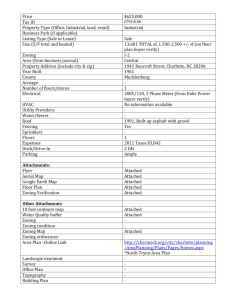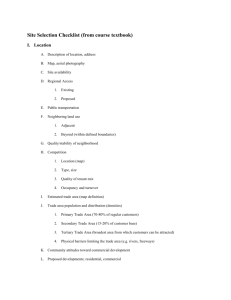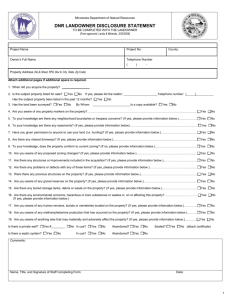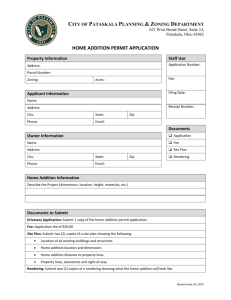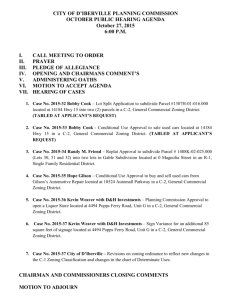AICP Exam Review: Planning and Land-Use Law
advertisement
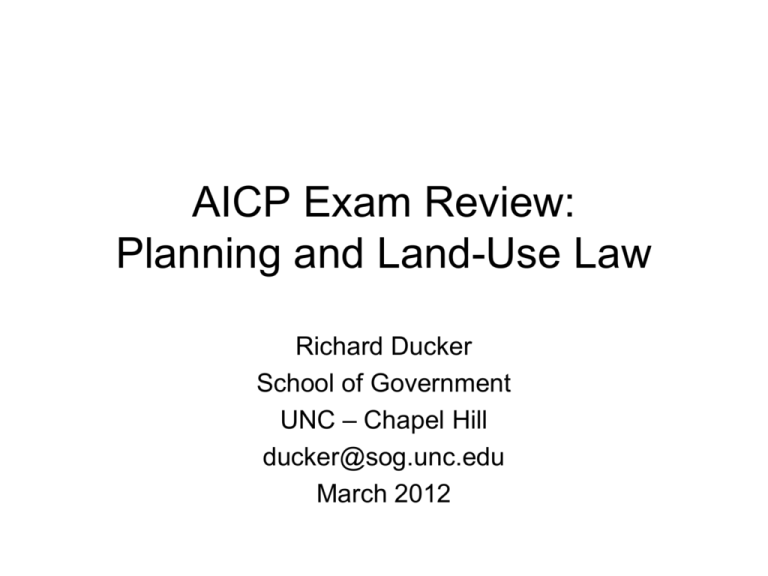
AICP Exam Review: Planning and Land-Use Law Richard Ducker School of Government UNC – Chapel Hill ducker@sog.unc.edu March 2012 PLANNING LAW Presentation Handout Introductory Memo Supplemental topic Outlines and Lists Notes on Transportation Planning Transportation Planning Development Environmental Protection and Other Topics General Problem Set Housing Notes Air Pollution and Global Warming Big Cases Annotated Planning Law Outline Planning Law Case Chart Skeletal Outline Land Use Law Raleigh Affordable Housing Glossary Answers General Problem Set Governmental Powers • Eminent domain – Public use, just compensation • Power to tax • Police power – Protect health, safety, and general welfare • Power to spend • Power to contract Police Power • Enabling authority • Home rule vs. Dillon’s Rule • Preemption • Initiatives /referenda • Delegation of power Constitutional Principles • Substantive due process • Procedural due process • Equal protection • First Amendment • “Takings” Clause Constitutional Principles • Substantive due process • Procedural due process • Equal protection • First Amendment • “Takings” Clause The “Taking” Clause of the U.S. Constitution • • Private property may not be taken for public use, except upon the payment of just compensation Applies to eminent domain – Public Use Clause allows eminent domain to acquire blighted properties for urban redevelopment (Berman) – Also allows eminent domain for economic development purposes (Kelo) • Also applies where government action results in physical invasion and occupation The “Taking” Clause of the U.S. Constitution • Regulation, like condemnation, may amount to a taking, requiring $$$ • If a taking is found, “temporary damages” are due for the period the restriction was in effect • First English Evangelical Church The “Taking” Clause of the U.S. Constitution Lucas Site • Never a taking to abate a nuisance • Always a taking if physical invasion of property by govt. • Always a taking if regulation deprives land of all beneficial use (Lucas) The “Taking” Clause of the U.S. Constitution • Otherwise “taking” depends on : – Nature of government’s interest – Economic impact of regulation on owner – Possible interference with property owner’s investment-backed expectations • Penn Central; Palazzolo Idea of a regulatory taking least implicated where • (1) Plat approval condition requires dedication of entire width of new highway bisecting subdivision • (2) Land is rezoned to “resource conservation district” allowing few, if any, developed uses • (3) Town refuses to allow private school in district that allows public schools • (4) Ordinance amendment requires owner of salvage yard to move to another location within a month after adoption Nollan Site Lucas Site Lucas Site Lake Tahoe Site Palazzolo Site Basic Zoning Concepts • Zoning districts • Jurisdiction of zoning • Nonconformities • Vested rights • Development agreements Typical Zoning Standards • Permitted uses: – Uses by right – Uses by special- or conditional-use permit • Other development standards: – Setbacks, height, FAR, impervious surface – Buffers – Off-street parking – Landscaping/tree protection – On-premises signs – Lot access/circulation Which statement about landscaping and tree protection requirements is false? • (1) Developers often comply with landscaping regs by clearing and then replanting • (2) Tree protection requirements are designed to protect trees with trunks smaller than certain caliper to protect during maturation • (3) Tree protection regs require developer to identify trees with certain features and show as part of protection plan • (4) Some LGs allow occupancy of commercial developments before landscaping reqs. met Flexible Zoning Techniques • • • • Floating zones Overlay zones Incentive zoning Performance requirements • United development ordinance • Form-based codes Nonconformities, Amortization, and Vested Rights • Nonconformity – a feature that doesn’t meet current standards • Amortization - phasing out nonconformities over time • Vested right - right to complete project under old rules Vested Right • Right to complete project under “old” rules • Established by – Substantial expenditures in reliance – Valid building permit – Approved site-specific development plan – Development agreement – Other Developer (D) obtained bldg. permits for apartments on R-MF site. Neighbors in adjacent R-SF area object. Now council rezones developer’s tract to R-SF. Which statement is true? • (1) D may be prevented from completing project if C/O not obtained before rezoning. • (2) Action involves downzoning, which is by its nature legally impermissible • (3) Since D obtained permits before rezoning, the project will be conforming when completed • (4) The owners of the property proposed to be subject of the rezoning are only ones that may submit a petition proposing it. • (5) None of the above. Zoning of Specific Activities • • • • • Single-family residential Manufactured housing Historic preservation Signs and billboards Sexually oriented businesses • Telecommunication towers Zoning of Specific Activities: SingleFamily Residential • Belle Terre allows limit on # of unrelated living together • Moore prohibits limits on # of related living together • Federal Fair Housing Act prohibits discrimination basis of disability or family status, may preempt regulation of group homes • Minimum housing occupancy standards OK (City of Edmonds) Manufactured Housing Legislation • Nat. Manufactured Housing Construction and Safety Standards Act (1974) prevents others from adopting different construction/safety standards for “manufactured homes” • Does not preempt local zoning • Dimensional and appearance standards for manufactured housing common in some states • Some states prohibit exclusion of manufactured homes Federal Aviation Legislation • U.S. (FAA) sovereign over – Navigable airspace management – Aircraft safety – Airport facility development – Aircraft noise • Government airport proprietors may also adopt noise regulations • Local land use regulations may apply to – Use of land around airports – Location and impact of air facilities – Ground operations – Number and type of aircraft using airports National Historic Preservation Legislation • National Historic Preservation Act – Allows Sec’y of Interior to maintain National Register of Historic Places (individual properties or districts) – If owners fail to consent to nomination, property not listed, but remains “eligible” and comes under federal review procedures – Advisory Council on Historic Preservation reviews projects that feds sponsor assist, or approve properties listed on Register or eligible for listing • Federal tax incentives for rehabilitation of certified historic structures Zoning of Specific Activities: Signs and Billboards • • • First Amendment protects all forms of speech, but off-site commercial signs may be prohibited in some cases Metromedia Even political signs may be banned from public rights-ofway (Taxpayers for Vincent) Local regulation more restrictive than federal outdoor advertising control program (administered by state DOTs along federally funded highways) but federal program effectively bans the amortization of nonconforming signs by local governments Which one of the statements concerning sign control is true? • (1) Not permissible under the First Amendment to ban commercial off-premises advertising signs entirely from a LG’s jurisdiction • (2) Federal legislation controls how, when, and where campaign and other political signs are erected and displayed • (3) If outdoor advertising signs along NHS are made nonconforming by LG, signs may not be amortized unless owners paid “just compensation” or a portion of state’s federal highway aid is jeopardized • (4) In a local sign ordinance signs bearing commercial messages may not be restricted more than signs bearing noncommercial messages Zoning of Specific Activities: Sexually Oriented Businesses • SOBs (“adult businesses”) implicate First Amendment right of expression and may not be entirely prohibited • Zoning standards must directed to minimizing “secondary impacts” • Impacts must be documented, but studies from other cities may be used Zoning of Specific Activities: Telecommunication Towers • 1996 Federal Telecom. Act prohibits local governments in siting decisions from: – Discriminating among providers – Effectively prohibiting wireless service – Denying permit because of certain radio frequency emissions • 2012 amendments mandate local approval for certain changes to an existing wireless tower/base station Zoning of Specific Activities: Religious Uses • Establishment Clause (law can’t advance religion or involve entanglements with it) • Free Exercise Clause (law OK if valid and neutral and of general applicability) Religious Land Use and Institutionalized Persons Act (RLUIPA) • Land-use regulation that imposes a “substantial burden” on exercise of religion must be justified by compelling govt. interest • Govt. may not exclude or discriminate against a religious assembly, or treat it on less than equal terms than a nonreligious assembly Exclusionary and Inclusionary Controls • Low- and moderateincome housing • Fair share • Legal basis Discriminatory Zoning – Race • Violation of U.S. Const. requires racially discriminatory intent (disparate treatment) • Federal Fair Housing Act makes it unlawful to “make unavailable, or deny, a dwelling to any person because of race”; requires only discriminatory effect (disparate impact) Discriminatory Zoning Handicap • Federal Fair Housing Act invalidates zoning if it discriminates against handicapped (e.g., group home separation standards, occupancy restrictions) • Illegal to refuse to make “reasonable accommodations” in rules when necessary Discriminatory Zoning – Familial Status • Federal Fair Housing Act prohibits discrimination against children • It does allow reasonable restrictions on maximum number of occupants permitted to occupy dwelling Quasi-Judicial Zoning Decisions • May include decisions of governing board, planning board, zoning board of adjustment • Require evidentiary hearing • Involve discretionary standards requiring fact-finding • May apply to variances, conditional-use permits, appeals of interpretations Quasi-Judicial Zoning Decisions • Based on standards of ordinance • Based on evidence at hearing • No bias, conflict of interest, or communication with parties outside hearing Conditional-Use Permits • Apply to uses requiring special review • Involve general standards such as: (“The use may not substantially diminish the value of adjoining property.”) • Requires quasi-judicial hearing • Development conditions may be added to permit Variances • Based on practical difficulties or unnecessary hardships • Site-specific permit conditions allowed if needed to grant permit Legislative Zoning Decisions: Zoning Amendments • Spot zoning – Spot zoning presumptively illegal unless reasonable basis – Factors in what’s reasonable • • • • Size of rezoned area Relation to plan Degree of change in uses allowed Relative harm and benefit to owner, neighbors, community • Contract and conditional zoning – Legal concern about LG agreeing to limit the future exercise of its legislative power • Zoning consistently with plan Land Subdivision Control Issues • • • • • • Streamlining review procedures Guaranteeing developer performance Appropriate development standards Cul-de-sacs vs. street extensions Improvements: public or private Cost-sharing and exaction policies Developer Exactions • Condition of development approval that developer provide for a public facility at developer’s own expense Developer Exactions • Compulsory dedication • Construction or improvement requirements • Payments in lieu • Impact fees • Constitutional test Thoroughfare plan shows proposed 4-lane road with r-o-w width of 90 feet. Road now has two lanes and 50foot r-o-w. Shallow but wide parcel with frontage of about 250 feet proposed for SUP for a car upholstery shop of about 3,000 feet of floor area. Town wants applicant to dedicate 40 feet of r-o-w along frontage. Which of the following court cases is the most relevant? • • • • • (1) (2) (3) (4) (5) Lucas v. South Carolina Coastal Council Dolan v. City of Tigard Kelo v. City of New London Penn Central Transportation Co. v. City of New York First English Evangelical Lutheran Church v. County of Los Angeles Developer Exactions • To meet constitutional test in Dolan: – Exaction must be roughly proportional to impacts caused by proposal – Precise calculation not required – Individual determination needed – Burden of proving constitutionality is on governmental unit – Local Growth Management • Moratoria • Adequate public facilities • Quotas • Urban growth boundaries • Public facility extension limits (urban service boundary) Local Growth Management: Moratoria • Drastic restriction, limited time, stop-gap measure • Seriousness of problem, tie to problem alleviation, long-run solution • Duration • Tahoe-Sierra Preservation Council Local Growth Management: Adequate Public Facilities • Linking development permission to availability of public facilities • Idea of concurrency • Comprehensive plan and CIP • Good-faith effort to increase capacity • Town of Ramapo Local Growth Management: Quotas • Cap on number of development approvals within certain time period • Comprehensive growth management plan needed • May or may not be tied to inadequate public facilities or environmental problems • Upheld in Petaluma Local Growth Management: Urban Growth Boundary • Urban growth allowed within but restricted outside it • Provision of urban services generally tied to growth areas • More common variation is a number of service areas or “tiers” as a means of directing growth Local Growth Management: Urban Service Boundary • Area within which urban services (primarily utility services) will be extended within certain time periods • Effective technique for cities to use in areas outside municipal limits where no legal duty to serve Zoning and Planning • Zoning “in accordance with a comprehensive plan” • “Consistent” with the land use plan – Map – Policies • State growth management legislation State Growth Management Programs • State legislation establishes program • Local govts. prepare comprehensive plans • State/regional agency review local plans • State incentives and penalties encourage compliance State Growth Management Programs • Vermont-Regional review of local plans • Florida- Concurrency of infrastructure and development • Maryland- Local plans designate priority funding areas State Growth Management Programs • Oregon - Use of urban growth boundaries • Rhode Island - Required local plans consistent with state plans and zoning • Washington - Local plans and urban growth boundaries for high-growth areas Environmental Programs • Wetlands • Floodplains • Agricultural land preservation • Environmental impact statements • Transfer of development rights • Coastal management • Endangered species Environmental Programs: Wetlands • • • • Section 404 of Clean Water Act requires permit to discharge dredge or fill U.S. waters Administered jointly by Army Corps and EPA Policy of no net loss of wetlands Permit standards: – – – No permit if practical alternatives Practical alternatives presumed if not water dependent Minimize adverse impacts through mitigation • Restoration • Creation • Purchases • Palazzolo, Lucas Environmental Programs: Flood Hazard Areas • • • • • Includes stream channel, overbank area, and adjacent floodway fringe Development generally prohibited in floodway Structures allowed in fringe, if elevated, or floodproofed Federal Flood Insurance Program; voluntary, but requirement for loan from private lenders regulated or insured by feds or for receipt of subsidized flood insurance First English, Lucas Environmental Programs: Agricultural Land Preservation • Incentive programs – Preferential assessment of ag land at use value – Voluntary ag districts • Limitations on special assessments and eminent domain – Right-to-farm laws – Conservation easements • Agricultural zoning Environmental Programs: Environmental Impact Statements • NEPA applies to major fed actions significantly affecting environment – – – • • Guidelines set by Council on Environmental Quality EIS must be considered before decision made – – • • • Federally initiated Federally permitted Federally funded If project, at feasibility stage If permit, after application received Categorical exclusion (CE) Environmental assessment (EA) Finding of no significant impact (FONSI) Environmental Programs: Transfer of Development Rights • Property rights may be • May result in significant differences in density between sending districts and receiving districts May be used for natural area protection (Pinelands (NJ), farmland protection (Maryland), and open space protection (Santa Monica Mountains) Development rights bank possible Penn Central, Suitum • • • – – – Severed from land Held or sold Exercised for development of other land Environmental Programs: Coastal Zone Management • • • CZM Act of 1972 admin. by National Oceanic and Atmospheric Administration NOAA approves state coastal management programs Two incentives – Federal funding for program development – Federal consistency requirement • Section 307 requires feds to act consistently with policies of approved state programs • State must issue letter of concurrence to federal agencies Environmental Programs: Endangered Species • • • • Allows U.S. Fish and Wildlife Service (and NOAA) to: – List species as threatened or endangered – Designate areas of “critical habitat” & recovery plan Federal agency authorizing funding, or undertaking project must consult with Sec’y of Interior to ensure action will not jeopardize species or destroy critical habitat Habitat conservation plans (HCP) may be required for private parties seeking “incidental taking” permit Babbitt Acronyms of Planning and Zoning • LULU • NIMTOO • NIMBY • WIFI • NIMFYE • CAVE • PIITBY • BANANA • NIMEY Thanks for your attention and participation Richard Ducker School of Government UNC – Chapel Hill ducker@sog.unc.edu March 2012 Supplemental Slides Richard Ducker School of Government UNC – Chapel Hill ducker@sog.unc.edu Transportation Planning: Early Federal Influence (I) • Fed. Hwy Act of 1963 requires urban areas to use “continuing, comprehensive, and cooperative” (3C) trans. planning process to qualify for federal funding process • 1966 amendment (sec. 4(f)) allowed USDOT to approve facilities through public park lands, wildlife refuges, and historic sites only if “there is no feasible and prudent alternative” Transportation Planning Early Federal Influence (II) • National Environmental Policy Act of 1969: environmental assessment of all federally funded projects • 1975: USDOT required development of 20-year transportation plans that included consideration of Transportation Systems Management (TSM) policies (e.g., carpool lanes, ramp metering, limited parking) to reduce peak-hour travel Transportation Planning The Transportation-Air Quality Connection • Clean Air Act of 1970 required all states to adopt a SIP (state implementation plan) with emission inventory for each air quality control region (AQCRs) and plan for attaining all ambient fed air quality standards Transportation Planning “Nonattainment” Penalties and TCMs • • Clean Air Act of 1990 provided that fed. funds may be withheld from regions that adopt plans but cannot show attainment through emissions reductions by the deadlines for each pollutant Act also strengthened demand-side policies by requiring Transp. Control Measures (TCM) be studied in nonattainment regions, and listed TCMs that must be studied for each level of nonattainment (moderate, serious, severe, and extreme) Transportation Planning: Changes Brought by ISTEA • • • • 1991 Intermodal Surface Transp. Efficiency Act of 1991 allowed funds heretofore reserved for highway projects to be used for all surface modes of transportation (walking, biking, transit) Gave priority to managing existing transp. facilities more efficiently Expanded role of MPOs in funding decisions Required comprehensive regional and statewide longterm transp. plans Transportation Planning Federal “Conformity” Rule for MPOs • • Federal rule adopted after ISTEA (the “conformity “ rule) requires all regions with ozone or carbon dioxide nonattainment to recalibrate model to take into account effect of changes in accessibility on travel demand Conformity rule also requires land development effects of regional plans be accounted for in regions with at least “serious” conditions and requires land-use patterns and facility plans to be consistent with each alternative Transportation Planning: Four Steps for Travel Modeling • • • • • (1) Trip generation (predicts the number of daily household trips); (2) Trip distribution (predicts where each trip goes); (3) Modal choice (predicts which travel mode chosen); (4) Route assignment (predicts travelers’ routes on roads, rail lines, or bus lines). Traffic flow then described in terms of volume (quantity) and in terms of speed (quality). Transportation Planning The Local Land Use-Transportation Connection • Access management (preventing traffic from adjacent land uses from compromising function of road) • Corridor protection (preventing new land development from compromising possible corridors for existing roads or roads on new alignment Air Pollution and Global Warming • A greenhouse gas is an atmospheric gas that contributes to the greenhouse effect by absorbing infrared radiation produced by solar warming of the Earth's surface. They include carbon dioxide (CO2), methane (CH4), nitrous oxide (NO2), and water vapor. Air Pollution and Global Warming • • In 2007 U.S. Supreme Court ruled that the Clean Air Act authorizes EPA to regulate greenhouse emissions (particularly carbon dioxide) EPA can avoid setting such standards only if it – finds that greenhouse gas emissions do not contribute to climate change, OR – can provide some reasonable explanation as to why the agency cannot or will not exercise its discretion to make such a finding.

